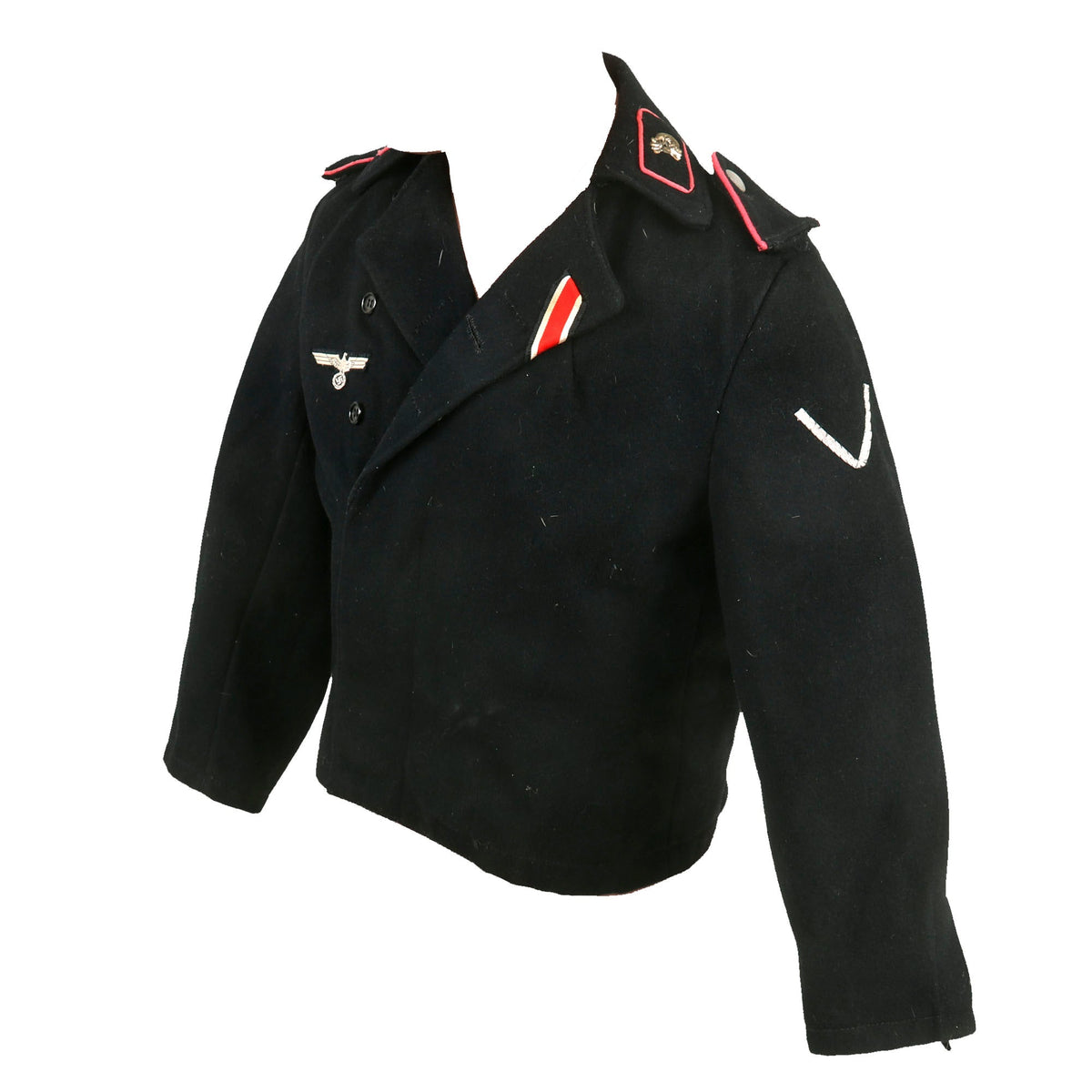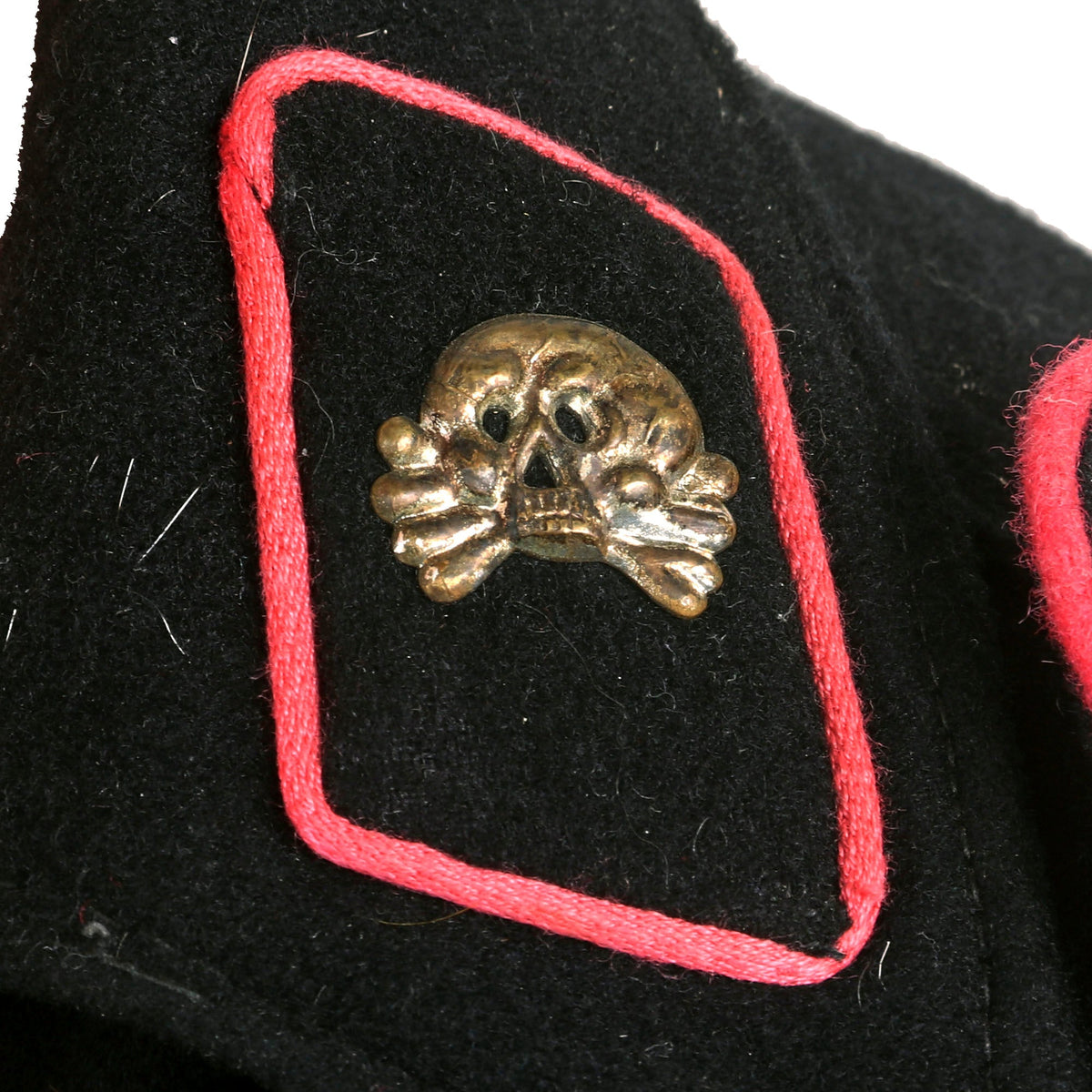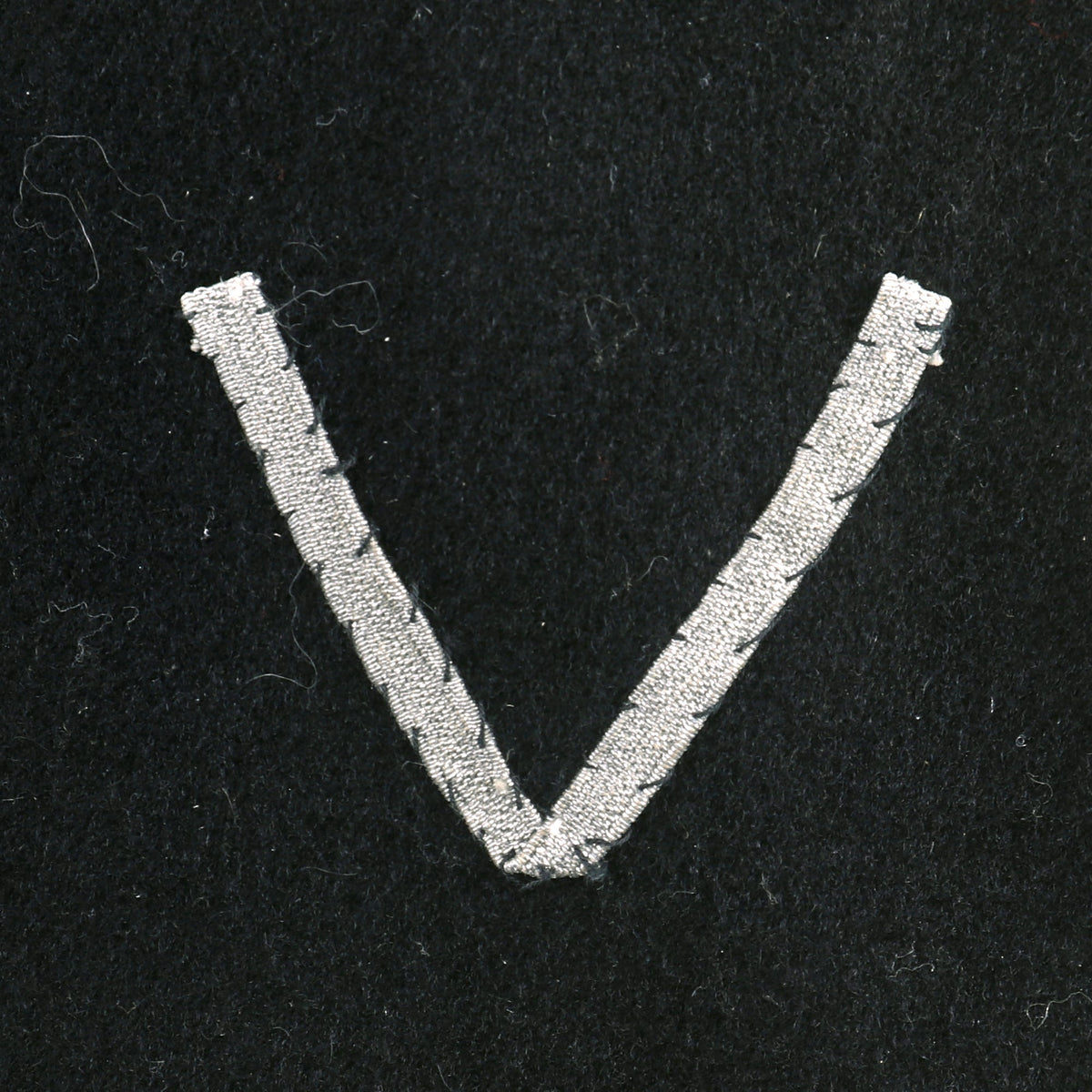Original German WWII Child Sized Heer Black Wool Panzer Wrap Uniform Tunic – Formerly Part of the A.A.F. Tank Museum Original Items
$ 895,00 $ 223,75
Original Item: Only One Available. Well this is definitely something we don’t see every day, and we probably won’t see one again anytime soon! This is a “Child Sized” Enlisted Man’s Panzer Wrapper, with all of the insignia scaled down to match, except for the metal Danziger Totenkopf skulls on the collar. We assume this was made for the child of a high ranking officer. The materials used, the stitching, and everything about it definitely looks to be original WWII. We unfortunately do not know much about the history of this item, but it sure looks the business!
The lovely child-sized panzer wrap tunic came to us from the American Armoured Foundation, Inc. Tank and Ordnance Memorial Museum. The AAF Tank Museum was a living memorial dedicated to the Tank and Cavalry soldiers of the world. Before 1981 some of the artifacts that make up the AAF Tank Museum was a private collection belonging to Mr. William Gasser. Mr. Gasser felt that his collection would be beneficial in educating present and future generations to the sacrifices made and the technologies gained during war. Therefore, in 1981 the AAF Tank Museum was established as a non-profit charitable organization, and Mr. Gasser’s donated his private collection to the Tank Museum. Mr. Gasser is still active as Volunteer Director and Curator of the Tank Museum and his knowledge of military history has been a great asset to the museum. Unfortunately after 20 years of operation it had to close its doors, which is when the wrapper was acquired.
Aside from the small size, it is a textbook black Panzer wrap tunic, or “Wrapper”, which have an iconic look that everyone loves. The black wool body shows very little wear, and has a front closure featuring 4 hidden bakelite buttons, with additional buttons on the interior and right side if the wrapper collar is buttoned up and not left open. The interior is partially lined with rayon on the sides, just like with full size wrappers we see. There is an internal slash pocket on the left inner chest, and even some inner waist adjustments for a tighter fit. The right chest bears a correct BeVo machine embroidered panzer eagle, which looks to be the size used normally on a cap, which is the perfect size for this scaled down tunic.
The collar is fitted with scaled down Panzer EM/NCO Kragenspiegelen (Collar Tabs), which are made using the correct black wool base material. Both feature rosa (rose- pink) piping around the edge. This is the Waffenfarbe (Corps Color) for the Panzertruppen (Armored Forces), as well as Kraftfahrkampftruppe – Kraftfahrtruppen (Motor Vehicle Combat Troops). In the middle of each tag is a great “Danziger” style Totenkopf (Death’s Head) insignia, made from plated brass. The shoulders both have scaled-down button-attached enlisted Schulterklappen (shoulder straps) made from black wool with the correct rose pink piping. There are no devices on the straps, but there is a silver tresse chevron on the left sleeve, indicating the rank of Gefreiter, equal to a U.S. Army “Acting Corporal”.
Really a great display piece, available at a fraction of a cost of the full size original. Ready to add to your collection!
Approximate Measurements:
Collar to shoulder: 8″
Shoulder to sleeve: 17”
Shoulder to shoulder: 13”
Chest width: 16″
Waist width: 18″
Front length: 19″
Panzer wraps are extremely rare because the armored corps made up only a small percentage of the Wehrmacht. The high amount of losses in the Panzer units is another reason remaining original examples ultra scarce. The garment would be a centerpiece in any uniform display and one-looker original panzer wraps like this one are very, very hard to find.
The first German tank, called a “Panzer” (for “armor”), appeared in 1918. In the interwar years, German military strategists discussed how this new weapon should be employed on future battlefields. The first Panzer Divisions were formed in 1935. The German approach to tanks was generally different from the concepts of other militaries. In the Wehrmacht, Panzers would lead operations. They would be able to conduct operations independently from other units. This innovative approach was a crucial part of the German “Blitzkrieg” strategy, that yielded great German victories in the early years of World War II. The Wehrmacht attempted to achieve further successes with Panzers by constantly introducing new and better tanks with greater destructive capabilities, or other armored fighting vehicles suited for more specialized roles. Eventually, the German Army would field nearly 50 Panzer Divisions; the Waffen-SS had an additional 7 Panzer divisions, and even the Luftwaffe had a Panzer division of their own. These were elite units, often engaged in constant combat on all fronts. Panzer crews wore distinctive black uniforms with deaths-head collar patches, and matching black field caps. Many Panzer commanders in the Heer and SS were highly successful in combat, and some even became well-known personalities in wartime Germany. Surviving material related to Panzer troops is extremely sought-after and collectible today.
Fast Shipping with Professional Packaging
Thanks to our longstanding association with UPS FedEx DHL, and other major international carriers, we are able to provide a range of shipping options. Our warehouse staff is expertly trained and will wrap your products according to our exact and precise specifications. Prior to shipping, your goods will be thoroughly examined and securely secured. We ship to thousands clients each day across multiple countries. This shows how we're dedicated to be the largest retailer on the internet. Warehouses and distribution centres can be located throughout Europe as well as the USA.
Note: Orders with more than one item will be assigned a processing date depending on the item.
Before shipping before shipping, we'll conduct a thorough inspection of the items you have ordered. Today, the majority of orders will be delivered within 48 hours. The delivery time will be between 3-7 days.
Returns
The stock is dynamic and we cannot completely manage it because multiple stakeholders are involved, including our factory and warehouse. So the actual stock may alter at any time. It's possible that you may not receive your order once the order has been made.
Our policy is valid for a period of 30 days. If you don't receive the product within 30 days, we are not able to issue a refund or an exchange.
You can only return an item if it is unused and in the same state as the day you received it. You must have the item in its original packaging.
Related products
Uncategorized
Uncategorized
Uncategorized
Uncategorized
Uncategorized
Uncategorized
Armoured Fighting Vehicles of the World: AFVs of World War One (Hardcover Book) New Made Items
Uncategorized
Uncategorized
Uncategorized
Uncategorized
Uncategorized
Uncategorized
Uncategorized
Uncategorized
Uncategorized
Uncategorized
Uncategorized












































































